(Plus Tips for Buying, Storing, and Cooking)
Sweet potato, yam. Potato, potahto. It’s all the same, right?
The answer might surprise you.
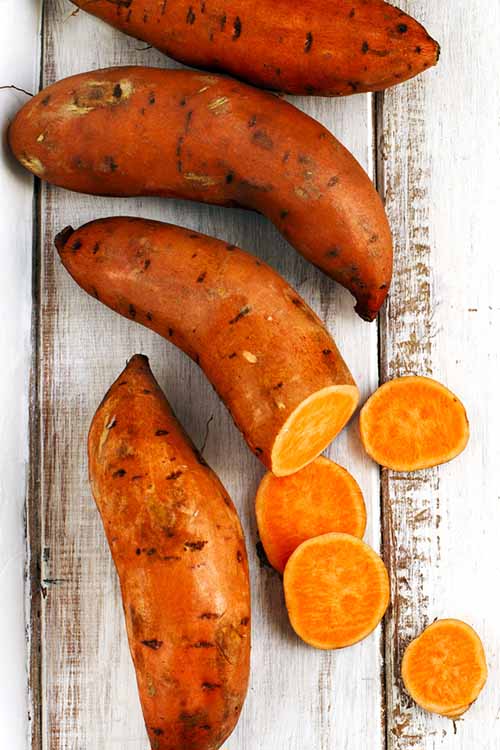
We know they are scrumptious in casseroles or steamed with melted butter and brown sugar. But do we know what sweet potatoes actually are?
Rather than call the whole thing off, it’s time to learn what we are really eating. Get ready for a crash course on one of the most popular vegetables in the world!
In this article, we will go over the following: its history, botanical basics, yam confusion, nutrition, choosing the best quality, storage, and uses.
Keep on reading for literally everything you need to know about this super spud!
Cultivating Culture and History
The sweet potato is a tropical plant native throughout the Americas. Tribes in North America were cultivating them by the time Columbus arrived, and he has been credited for introducing them to Europe.
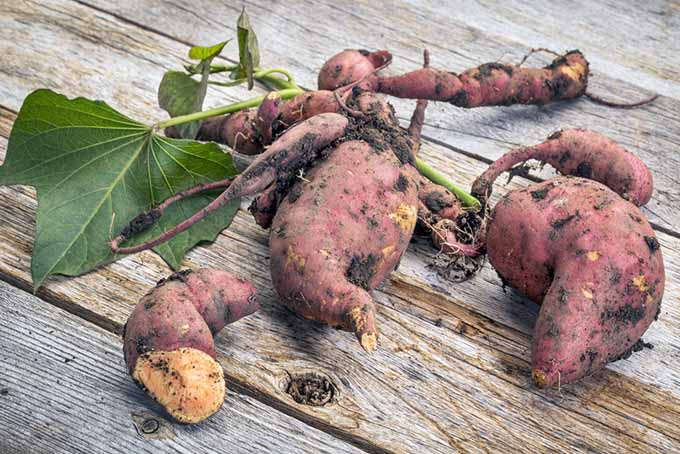
As trade routes became more prevalent throughout the world, the sweet potato’s popularity continued to grow. With its pleasing taste, nutritional value, and ease of agricultural production, it quickly became established as one of the most popular vegetable crops in the world, only second to the common white potato.
Because they thrive in warmer climates, the majority of sweet potatoes in the United States are grown in Southeastern states, most notably in North Carolina. The state has established the North Carolina Sweet Potato Commission, which provides education, support, and updates regarding the industry.
Naturally, they have become a popular ingredient in Appalachian and Southern cuisines.
Other than the classic pies, puddings, and casserole dishes covered in marshmallows, sweet potatoes are an old-time favorite for family bonfires in the South, where they are traditionally cooked whole in the ashes and served piping hot as a sugary and smoky end to a fun gathering.
Festivals throughout the world have been dedicated to sweet potato promotions, including the annual Louisiana Yambilee (complete with a crowning of the Yambilee Queen) and North Carolina’s Yam Festival in mid-October.
Curious to know more? Keep reading below to learn more about the science behind the plant!
Botanical Basics
Now, let’s see if your memory is aroused from long ago, on that terrifying first day of biology class…
Living organisms, including plants, are divided into a basic taxonomy system that organizes each item into applicable groups, from the broadest category of kingdom (plants, animals, etc.) to the most specific category of species.
We certainly don’t need to get into the long-winded Latin names of each category! There won’t be a test after this, I promise.
But what you should know is that the sweet potato belongs to the species Ipomoea batatas, which is part of the morning glory family and genus.

It includes many varieties (hundreds, actually), ranging in color, texture, and taste. From the dry and starchy varieties in tropical regions to the jewel-toned, sweeter varieties more common in the United States, there is endless worldwide diversity.
Jewel, Covington, Carolina Ruby, O’Henry… these are just a few of the many kinds available to consume!
Though they all share some of the broader taxonomic classifications, the common white potato, (from the family Solanaceae), and the yam, (from the family Dioscoreaceae), are very different from the sweet potato.
Not only are they each from a different family, genus, and species, they are also from entirely separate parts of plants.
Which brings us to our next subject:
Roots and Stems: Different Parts, Different Veggies
Harold McGee’s book, On Food and Cooking: The Science and Lore of the Kitchen, provides extensive research on plant anatomy. His descriptions will be our major source in this section, and the book is also available on Amazon.
McGee explains that plants have six major organs: root, stem, leaf, flower, fruit, and seed.
For the purpose of this article, we will go over roots and stems.
Root Vegetables
The roots are structured to be the underground anchor of the plant. While most roots from plants we consume are often too tough and fibrous to be edible, there is another category of roots.

Edible roots are made of nonfibrous storage cells that are able to swell with nutritious liquids, for the plant’s optimal survival in harsh weather conditions.
Sweet potatoes are anatomically identified as this type of root, along with carrots, parsnips, radishes, and manioc.
To find proof of their place among today’s pantheon of delicious root veggies, try throwing them into a toasty root vegetable roast, with some warming spices to boot.
Stem Vegetables
Stems, like celery and asparagus, serve the main responsibility of transporting essential nutrients from the roots to the rest of the plants.

Stems of certain plants have a unique reproductive advantage. These stems form a separate underground unit for the purpose of nonsexual reproduction, a method of continuing the plant’s growth and survival chances.
The stem is able to create an independently functioning storage unit, called a tuber, which is capable of producing its own roots and stem. The plant shares an identical genetic makeup to the original plant, but it is a self-sufficient entity.
Potatoes and yams are identified as these tubers. While they share a distant relation to sweet potatoes, they are botanically different.
Yam or Sweet Potato: A Marketing Ploy
After you recover from the feeling of being duped for all these years, thinking they were the same thing, continue reading below for more interesting info about these two spuds!
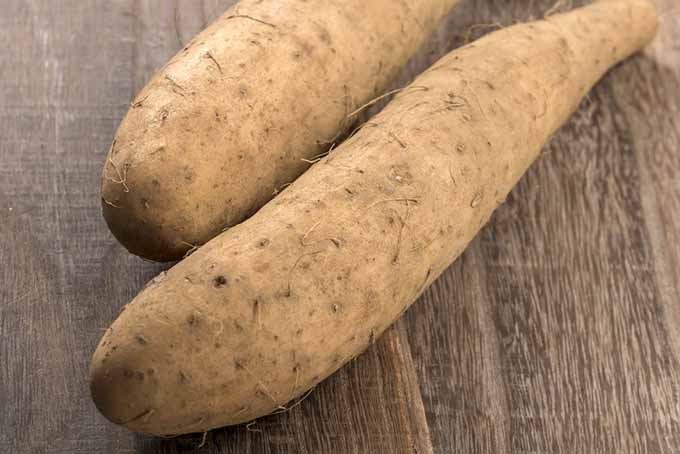
The true yam is a starchy, tough, white-fleshed tuber of a tropical plant indigenous to Africa, South America, and the Pacific. They can actually grow to over 100 pounds and up to 6 feet underground!
The yam is rarely available in most American supermarkets. What you see labeled as a yam is actually another darker-fleshed variety of sweet potato.
So, what’s with the mixup? Why are they labeled as yams?
Here is one of the major theories:
With sweet potatoes already a widespread trading crop in earlier centuries, slave traders from North America and Europe may have introduced them to tribes in Africa and other tropical nations, where the native yam (called nyami or nyam) was the common carbohydrate.
Since that introduction, indigenous tribes slowly began to popularize it as the more mainstream crop, but still used the name interchangeably with yam.
As tribes were brought to the Americas through the slave trade, they also brought the term yam with them, continuing to compare and refer to American-produced potato varieties as yams.
The name soon became adopted as a slang word for sweet potato throughout the Southern states.

Moving forward to the early 1930s, Southern farmers produced a new, dark orange variety of sweet potato. Marketers wanted to create a distinction between this sweeter variety and the drier, light yellow variety currently dominating the market.
The now commonplace term yam was ultimately the name given to this new crop, in all the mainstream markets.
And thus continued the linguistic confusion that exists to the present day!
So don’t be fooled the next time you go shopping. Those are probably all sweet potatoes displayed in the produce section, regardless of whatever the sign says!
A Carb-Happy Source of Nutrients
Whatever you decide to call them, there is no confusion about how healthy they are.

Sweet potatoes are one of the best sources of nutrient-dense carbohydrates, providing a multitude of vitamins and minerals.
One small sweet potato provides about 60 calories in complex carbohydrates. And it’s also a good source of dietary fiber if the skin is left on, offering about 4 grams.
But the fun doesn’t stop there.
It provides an astonishing number of vitamins and minerals as well, like B vitamins, phosphorous, magnesium, iron, copper, manganese, calcium, zinc, and chromium, just to name a few.
Due to the similarity of its texture when cooked, they are often used to replace the common white potato in a variety of dishes.
Solanaceae – the family to which potatoes, eggplant, tomatoes, and pepper varieties belong – is also referred to as the “nightshade” family. Nightshades have been linked to some common digestive issues such as inflammation, stomach pains, and indigestion.
Since sweet potatoes belong to a different botanical family, they are a perfect substitute in potato-based dishes for those following a nightshade-free diet.
How to Choose the Best Sweet Potato
Choosing the best quality at the market is easy!
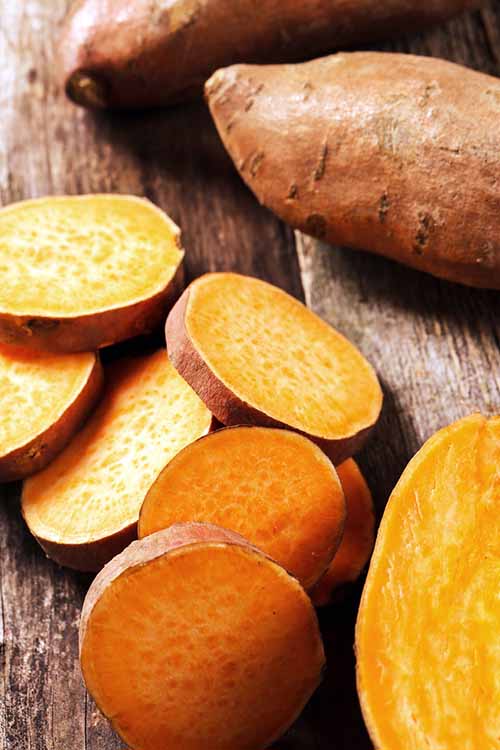
Unlike the regular potatoes (like russet or yukon varieties of the species Solanum tuberosum), you don’t need to look out for or worry about those green spots or sprouts.
In standard potatoes, such traits are a sign of built-up levels of solanine, due to exposure to sunlight. This is an alkaloid that is harmful to humans, and it is found in members of the nightshade family Solanaceae.
However, sweet potatoes (while still called potatoes) are not nightshades!
The sprouts of sweet potatoes are also edible, just like the root. And they’re nutritious, too. In fact, recipes for sweet potato greens can be found on the web.
You can also use the sprouts from sweet potatoes to grow whole new plants in your garden!
Weight is also a good indicator of a quality product. Remember, root vegetables store nutritious liquids and water, so they should feel heavy and plump.
If they appear shriveled and feel too light for their size, this may be a sign that the flesh has dried out.
Follow these rules to ensure you’re picking the top quality.
Don’t buy if:
- The skin looks moldy
- It feels soft and mushy
- It smells rotten
- It looks or feels shriveled or dried out
- It feels too light for its size
Do buy if:
- The skin looks fresh and plump
- It feels firm
- It has no rotten smell
- It feels heavy in the hand
Storage and Usage: Tips and Tricks
Room temperature storage in a dark, cool, well-ventilated spot is ideal. Great locations in your house for storage would be your basement or pantry.
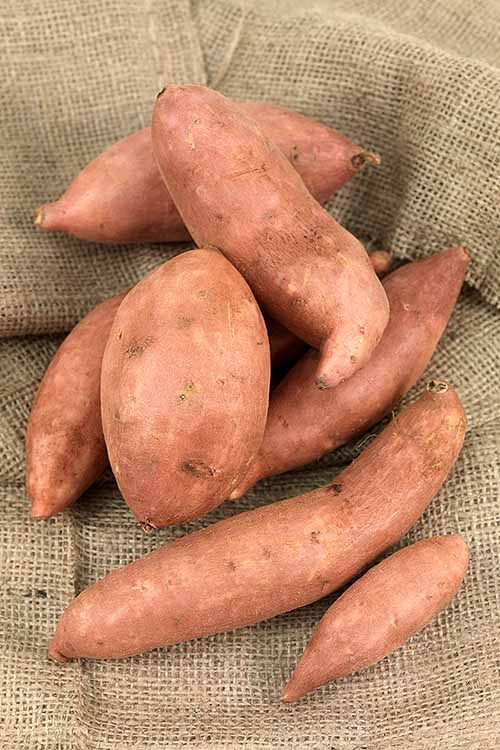
As long as they are properly stored away from light and any heat sources, these should last for up to 2 weeks, sometimes longer.
Do not store them near direct sunlight. Light promotes the development of chlorophyll production, and an excess amount causes them to become bitter. Green patches are physical signs of excess chlorophyll development.
We also recommend that you do not store them in the refrigerator, for a few reasons:
1. To Avoid Turning Starch into Sugar
Temperatures below 40°F advance the chemical reaction of turning starch into sugar.
Sweet potatoes already contain a naturally higher level of sugar than common potatoes. With an even higher sugar content after chilling, this will cause them to burn more easily, especially when you are making your next batch of fries.
2. To Avoid Damaging Your Produce
Chilling them in the refrigerator can also injure the interior structure, triggering a condition known as “hardcore,” where the core of the vegetable remains hard even after it is cooked.
A Perfect Foundation for Cooking
Roasted, baked, boiled, pureed, or mashed, this is an essential food product that can be masterfully used for all of your basic culinary and baking needs.
It’s ideal as a hash with peppers, onions, and herbs that can be used as a side to a meaty main, as a bed for fried eggs, or served on its own!
When mashed, it’s a nutritious and tasty substitute for the typical mashed white potatoes spread on top of a comforting scoop of shepherd’s pie.
And it is also used in ways that you may not expect.
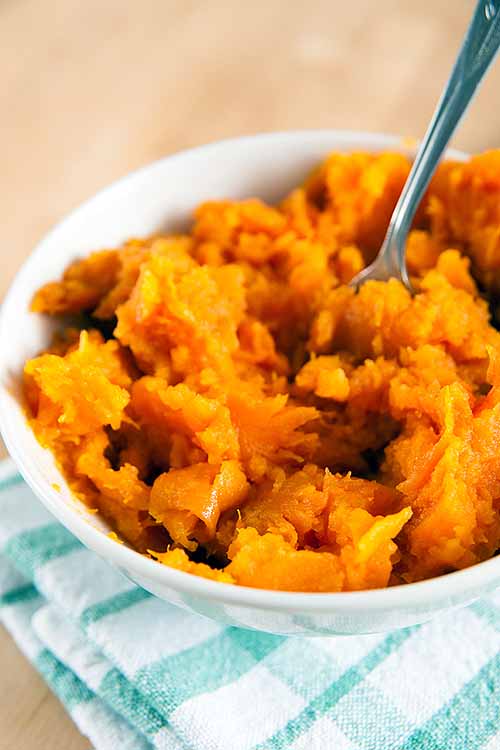
The pure starch extracted from it can be used to make gluten-free noodles, which are sold in many Asian supermarkets. Similar to mung bean or rice noodles, sweet potato noodles are translucent, often called glass or cellophane noodles.
When prepared properly (by simply soaking in a hot liquid for a few minutes), they still have the same chewy, al dente quality as other gluten-based noodles.
Speaking of noodles… we have a perfect recipe for spiralized sweet potato pasta! It’s a perfect Italian dish with sun-dried tomatoes, fire-roasted red peppers, and lots of cheese!
Searching for more recipes? Need an update from your typical casserole?
We here at Foodal love these delightful underground jewels. Take a look at a tasty round-up of our 19 favorite, must-try sweet potato recipes!
Further Exploration: What Do You Think?
With its unique botanical structure and fun history, it is no surprise that this versatile, brightly colored carbohydrate is one of the most popular crops enjoyed worldwide!
We hope our crash course has inspired you to look beyond the food labels, so to speak, and continue the exciting pursuit of learning about what you buy and consume every day.
There will always be more to explore… and more to eat!
Please post your comments below, and share your own lessons learned with these delicious roots.
Photo credits: Shutterstock.
About Nikki Cervone
Nikki Cervone is an ACS Certified Cheese Professional and cheesemonger living in Pittsburgh. Nikki holds an AAS in baking/pastry from Westmoreland County Community College, a BA in Communications from Duquesne University, and an MLA in Gastronomy from Boston University. When she's not nibbling on her favorite cheeses or testing a batch of cupcakes, Nikki enjoys a healthy dose of yoga, wine, hiking, singing in the shower, and chocolate. Lots of chocolate.






Never knew that the yams were really sweet potatoes. I guess this means that any recipes that call for yams are also just asking for the sweet potato. Is it possible to make sweet potato chips? I’ll have to try and make those and the fries (which I’ve never tried before). Thanks for educating us.
You certainly can make sweet potato chips! There is a brand called Terra that sells bags of sweet potato chips, and they are excellent. The only problem is that they are pretty pricey. You can make your own for less money by slicing the sweet potatoes thinly and cooking them in a pan of oil or a deep fryer, like you would with potato chips. I’ve never personally tried this, but I think you could also use a food dehydrator to make a healthier version. I like to season them with seasoning salt, or the Terra chips sometimes have a lemon and herb Mediterranean seasoning that I am sure would be easy to make. You know what also sounds yummy? Cinnamon sugar sweet potato chips!
I remember learning that a while back and rethinking a lot about what I thought of sweet potatoes. I gave them a little more credit, but on the whole I still really do not care for them. I like the regular old potatoes in most forms, but the sweetness just does not do it for me.
I never knew that fact, either! Well, it goes to show that you really never do stop learning. I assumed that yams were some wild fruit that grew in the deepest parts of jungles – don’t ask my why I had that idea or where I got it from…
I only buy fresh sweet potatoes once a year. It’s getting near that time! The problem I have with them is sometimes I will get a really stringy, just gross, product. I don’t know if this is because the inside has dried up. But I really haven’t noticed the weight of the potatoes. Does there make a difference in size versus quality? I mean, will a really big one be more stringy than a small one, or does it have to do with the moisture content?
When I buy them fresh for Thanksgiving, sometimes I feel like I’m rolling the dice, I usually buy several extras, so after I boil them I can choose the best ones to put in the casserole with brown sugar and butter. YUM. I just suck at picking out produce at the store.
I’ve always known sweet potatoes were healthier, but I was convinced yams tasted different. My dad eats quite a lot of them because he is diabetic and it helps stabilize his sugar levels and keeps some roasted sweet potatoes in the fridge for emergencies.
If you aren’t sure what to serve a diabetic, then this is an ideal dish whether you have them mashed or roasted.
I eat sweet potatoes everyday. I do not put anything on them. Lately, all the sweet potatoes I am buying ate bitter and starchy (very heavy) I have been to every grocery store around. Usually they are sweet. Why is this happening? Does anyone know a good brand of sweet potatoes I can buy online to insure they are good???
I completely understand your frustration! Textural issues are usually related to the variety. Many grocery stores do not properly label the sweet potato products they sell. And because there are so many varieties available (each with a different appearance, texture, and taste profile) it’s like taking a gamble with what you are buying.
I suggest gathering research before you shop. To learn more about the varieties, visit local farmer’s markets or Whole Foods locations – they typically have more information regarding their products. You can also go on the website of the North Carolina Sweet Potato Commission to get detailed info and images on some of the more popular varieties sold here in the United States. Typically, what is labeled in supermarkets as “yams” will be sweeter and have a softer flesh. Other typically sweeter and softer-fleshed kinds include the Covington and Jewel.
Thanks for the great info and resources. You are the best. The only thing that would have made it the end-all-to-be-all would have been a guide of sweet to sweetest Sweet Potato & which Sweet Potato has the most bestest vitamin, antioxidants and nutrients.
Thanks a lot!!! 🙂
Just to let you know that one little restaurant on the beach in Anna Marie Island has a bunch of Sweet Potato Chips piled high and has Marshmallow drizzled all around it with Cinnamon sprinkled over the top. Best Ever. What a treat. They didn’t always carry it, but when they did, you darn well bet you, we ordered it.